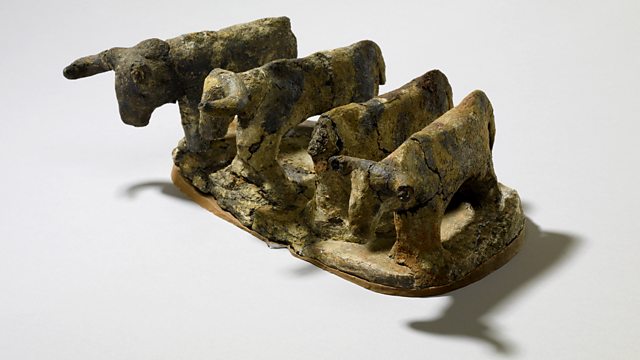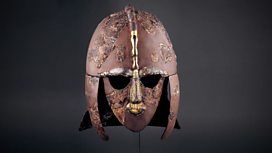Egyptian Clay Model of Cattle
Neil MacGregor's world history encounters four miniature cows made from Nile mud over 5, 500 years ago. considers the state of human culture in Egypt before the pharaohs
Neil MacGregor, in his history of mankind as told through objects at the British Museum, selects four miniature clay cows to show the major changes that early man was undergoing at the end of the Ice Age. These four frail looking cows were made from Nile mud in Egypt 5,500 years ago, way before the time of the pyramids or the pharaohs. Why did the Egyptians start burying objects like this one with their dead? Neil goes in search life and death on the Nile and discovers how the domestication of cattle made the humble cow transformed human existence.
Last on
![]()
Discover more programmes from A History of the World in 100 Objects about death and ritual
About this object
Location: Egypt
Culture: Ancient Egypt
Period: About 3500 BC
Material: Ceramic
This clay model of four cows was made in Egypt over 5000 years ago. It was placed in a grave, perhaps to provide its owner with food in the afterlife. Cows were revered in Egypt as a source of life in the harsh desert environment and whole cows were sometimes also buried with people. Later they were worshipped as the cow goddess Bat - the protector and mother of the pharaoh.
When were cows first domesticated?
Cows were first domesticated in North Africa in 8000 BC. After the Ice Age the earth had grown warmer and the lush savannah was transformed into the Sahara desert. As the climate became drier people became restricted to the Nile valley, where they relied on cows for food and as beasts of burden to carry water. Cows were also domesticated independently in the Middle East and today all cattle across the World are descendents of these Middle Eastern cows
Did you know?
- When cows were first domesticated people could not drink their milk. It took a long time for humans to become tolerant.
Tracing the earliest cattle
By Professor Diane Gifford-Gonzalez, Anthropologist, University of California
��
This figurine shows the form of the earliest domestic cattle in Africa, with high shoulders but without humps and graceful, lyre-shaped horns. They resemble modern Kuri cattle of Africa’s western Lake Chad.
Genetic studies shed light on when and where cattle were first domesticated. After the Ice Ages, wild cattle thrived from Pakistan and North India across the Near East into North Africa and Europe. DNA from living cattle and ancient bones suggests there were three domestications, that all took place 8,000-10,000 years ago.
One domestic line originated in the mountains that run from Turkey through to Iran. Humped cattle like India’s “sacred cows,” were domesticated around the Indus River Valley in the north-west of the country, and wild African cattle may have been domesticated in north-eastern Africa.
Modern African breeds have genetic markers that show they descend from a common regional gene pool. Europe’s cattle breeds descend from Southwest Asian stock which had been introduced into Europe by 7,500 years ago.
The remains of the earliest known African domestic cattle date to about 7,800 years ago. Humped cattle, including cross breeds common in Africa today, have South Asian ancestors.
Art from the time, made in the then-green Sahara, depicts spotted cows like these, with curving horns and full udders. Later Egyptian tomb paintings show cattle pulling plows and being milked. These pottery cattle were buried to offer help in the afterlife.
Transcript
Broadcasts
- Wed 27 Jan 2010 09:45������̳ Radio 4 FM
- Wed 27 Jan 2010 19:45������̳ Radio 4
- Thu 28 Jan 2010 00:30������̳ Radio 4
- Wed 22 Apr 2020 13:45������̳ Radio 4
Featured in...
![]()
Food and Farming—A History of the World in 100 Objects
A History of the World in 100 objects - Food and farming
![]()
Death—A History of the World in 100 Objects
More programmes from A History of the World which relate to the ritual of death.
Podcast
-
![]()
A History of the World in 100 Objects
Director of the British Museum, Neil MacGregor, retells humanity's history through objects





